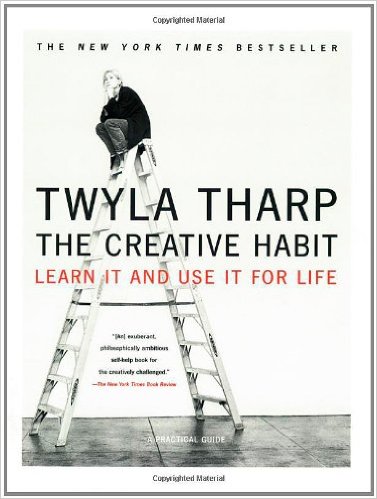The Creative Habit Summary
6 min read ⌚

MicroSummary: Written by world-renowned choreographer Twyla Tharp, “The Creative Habit” brushes off the nature vs. nurture debate, revealing how strict routines, organized effort, and a host of creative exercises may help almost everyone achieve greatness.
Learn It and Use It for Life
Stuck in a creative rut? Having troubles with organization whenever you want to turn a big idea intoa big project?
“The Creative Habit” may just be the book for you.
And in that case – this summary is certainly a must read.
Who Should Read “The Creative Habit”? And Why?
Whether you’re a genius or merely a creative trainee, we’re pretty sure that you are anxious whenever you’re starting a new project. In “The Creative Habit,” Twyla Tharp has few advices which you will certainly find both interesting and practical.
If you’re an artist, you’ll find both the analogies and the people mentioned in this book inspiring. And we guarantee you that you’ll want to try at least one or two of the organizational techniques.
At least – we’re planning to!
About Twyla Tharp
Twyla Tharp is a New York-based dancer, one of the greatest choreographers of the 20th century. She has created more than one hundred dances for the most prestigious ballet houses in the US, and the world.
is a New York-based dancer, one of the greatest choreographers of the 20th century. She has created more than one hundred dances for the most prestigious ballet houses in the US, and the world.
She has won two Emmy awards and a Tony award. In 1997, she was made an honorary member of the American Academy of Arts and Letters.
Read more at: https://www.twylatharp.org/
“The Creative Habit Summary”
It’s the good old nature vs. nurture showdown once again!
For all intents and purposes, Wolfgang Amadeus Mozart is the archetypal child prodigy. In other words, people think that he was born with much more talent than they are ever going to acquire.
Their argument: Mozart was composing and playing keyboard and violin at an age when you were barely able to tell your left from your right hand. Now, clearly, they are on to something!
Round 1: Nature beats Nurture to the first punch!
But, did you also know that Mozart practiced and wrote so regularly and so prolifically that by the time he died – and he died at 35 – his fingers were deformed?
Round 2: Nurture strikes back!
So, unsurprisingly – once again it’s a draw.
Understandably, Twyla Tharp is in Nature’s corner: you can’t really do anything about your genes, but you can do a lot about how you use their potential!
That’s lesson number 1: you can be born a genius, but just like a natural-born boxer, you’ll get nowhere if you don’t flex your creativity muscle from time to time!
But, before you start exercising it, you need to discover it! Because even if you have the knack for dancing like Twyla Tharp, you may never find this out if your father sends you to learn boxing!
Hey, wait a minute! That’s the plot of Billy Elliot!
Let’s work together toward the happily-ever-after ending, shall we?
As we said above, the first step is to learn who you are and what you really like in life. The Ancient Greeks pinned it in a much more direct and concise manner: know thyself! For example, ask yourself what would you want to be, if there were no financial or logistical limitations. Or, even more creatively, ask yourself which name would you choose if you want to reinvent yourself at this moment.
Twyla Tharp retells a story about one interesting moment of enlightenment an art student experienced during a similar exercise. She asked the student to assign colors to a dance and music improvisation. Instead of a list of colors, he gave a 500-word exposé where the only color he mentioned was “limpid blue.”
The art student went on to become a writer. Up to this moment, he was in a state of DNA denial. Nurture works wonders – but it’s better if it has a foundation!
And nurture sets off when work becomes a routine!
True, it may be boring from time to time, but bear in mind that Stravinsky played a Bach fugue each and every day of his life. And he became a Stravinsky!
Practice makes perfect because that’s how your brain knows what you want to remember. And because that’s how your brain is fed with relevant information in order to build upon them for an idea of your own.
In fact, that’s originality! It’s not something mythical and unattainable. It’s something everybody can reach through hard work. When done elegantly and creatively, in art – stealing is legal. As a matter of fact, all but one of Shakespeare’s plots are not lifted from someone else’s books.
And what we just said – well, it’s not an original idea as well!
So, if you want to be original, learn how to steal. It sounds a lot worse than it actually is. Maybe that’s why Twyla Tharp uses the phrase “scratching for ideas.” In essence, it means finding anything which may sound interesting and relevant and save it, record it, or store it.
Make it much more literal!
Take a box and put these things inside. Open the box and look at them from time to time, trying to find some connection. When that clicks – take out the things which connected and put them in another box.
This box now represents your main idea. Tharp calls it your spine.
Develop it. See which skills are necessary to support the spine. For example, the spine of Herman Melville’s “Moby-Dick” is a simple idea: “get the whale.” However, supporting it, means finding out everything you can about writing novels, whales, sea life, obsessions, etc.
Just look at the amount of investigation that went into the Extracts section of “Moby-Dick”! These are thousands and thousands of hours research!
Which brings us to the final point:
Persevere! There will be ruts and there will be failures. But if you are as obsessed as Ahab with your project, sooner or later, you’ll get your eureka moment!
Key Lessons from “The Creative Habit”
1. Don’t Reinvent the Wheel: Learn from the Past Masters
2. Sometimes Necessity Can Be the Mother of Invention
3. Now and Then – Do Leave for Tomorrow That Which You Can Do Today
Don’t Reinvent the Wheel: Learn from the Past Masters
Now, don’t get us wrong – even the Mesopotamians and the Ancient Hebrews thought that there’s nothing new under the sun. And yet – how much the world has evolved in the meantime!
However, every single step forward you can think of was made through recombination! And each of the skills which allowed this to happen was developed through repetition.
So, do it!
Copy the past masters if you’re a painter, rewrite the old poems if you’re a poet. Because you’ll be able to move forward only if you get to the bottom of them!
Sometimes Necessity Can Be the Mother of Invention
Too little organization will get you nowhere! But, too much organization doesn’t work either! Sometimes, you may have to find a way to enjoy in the discomfort of deadlines and lack of resources! Just take Steven Spielberg for example: he got his best “Jaws” idea because he didn’t have the money to build an artificial shark!
Now and Then – Do Leave for Tomorrow That Which You Can Do Today
Benjamin Franklin left to the world many good advises. Not leaving anything you can do today for tomorrow wasn’t his best one – at least in terms of creativity.
Because, it’s good to have a bridge – and know your next step from the moment you wake up. Hemingway, for example, purposefully stopped at the most interesting part each day – so as to get the necessary fuel for the next morning!
Like this summary? We’d Like to invite you to download our free 12 min app, for more amazing summaries and audiobooks.
“The Creative Habit” Quotes
I read for growth, firmly believing that what you are today and what you will be in five years depends on two things: the people you meet and the books you read. Share on X When I walk into the studio I am alone, but I am alone with my body, ambition, ideas, passions, needs, memories, goals, prejudices, distractions, fears. Share on X Before you can think out of the box, you have to start with a box. Share on X When you're in a rut, you have to question everything except your ability to get out of it. Share on X You may wonder which came first: the skill or the hard work. But that's a moot point. The Zen master cleans his own studio. So should you. Share on XOur Critical Review
“The Creative Habit” is written by a person with admirable creative habits: even in her seventies, Twyla Tharp still goes to the gym after drinking her morning coffee. If that’s not a good blurb for a book with this kind of title – we don’t know what is!
Emir is the Head of Marketing at 12min. In his spare time, he loves to meditate and play soccer.







